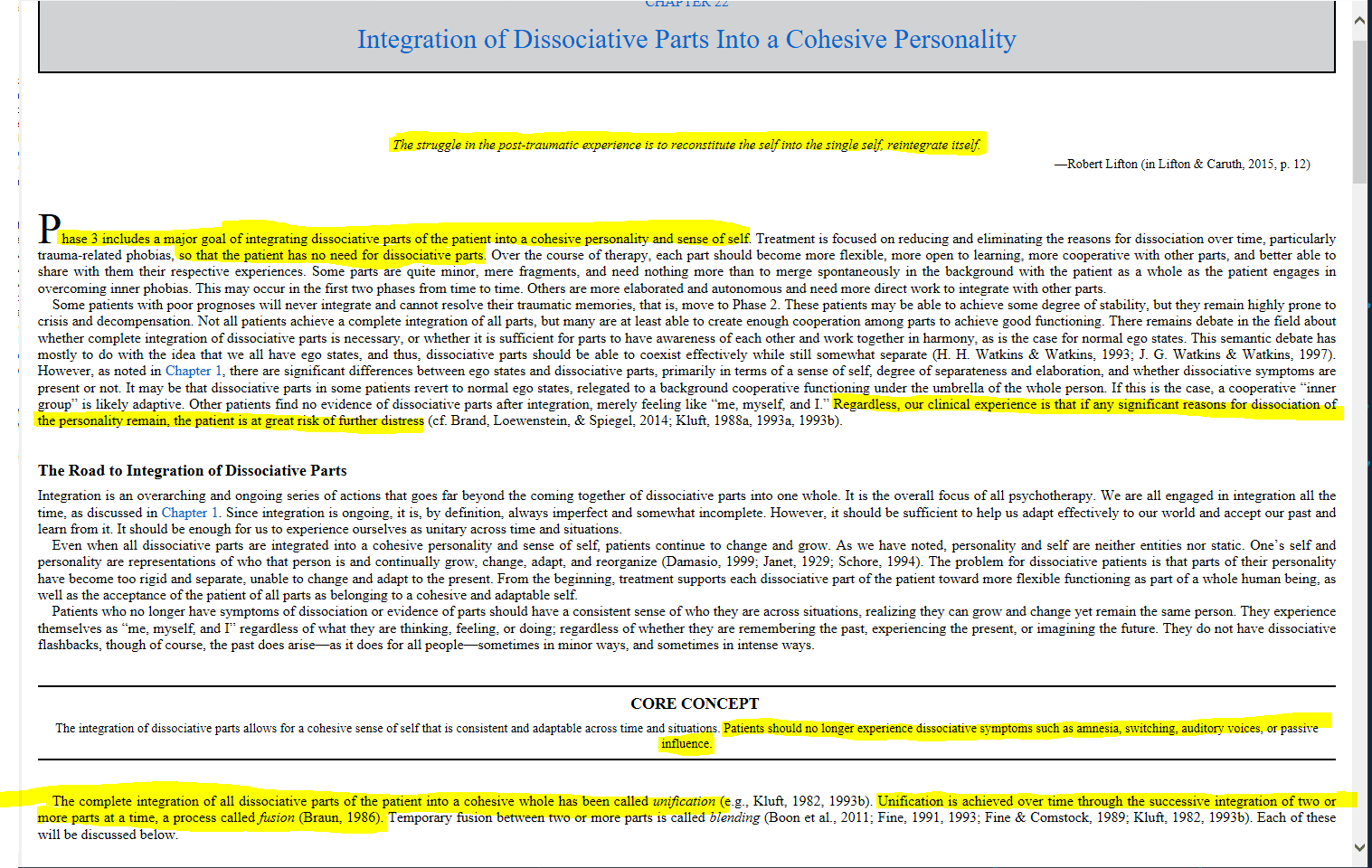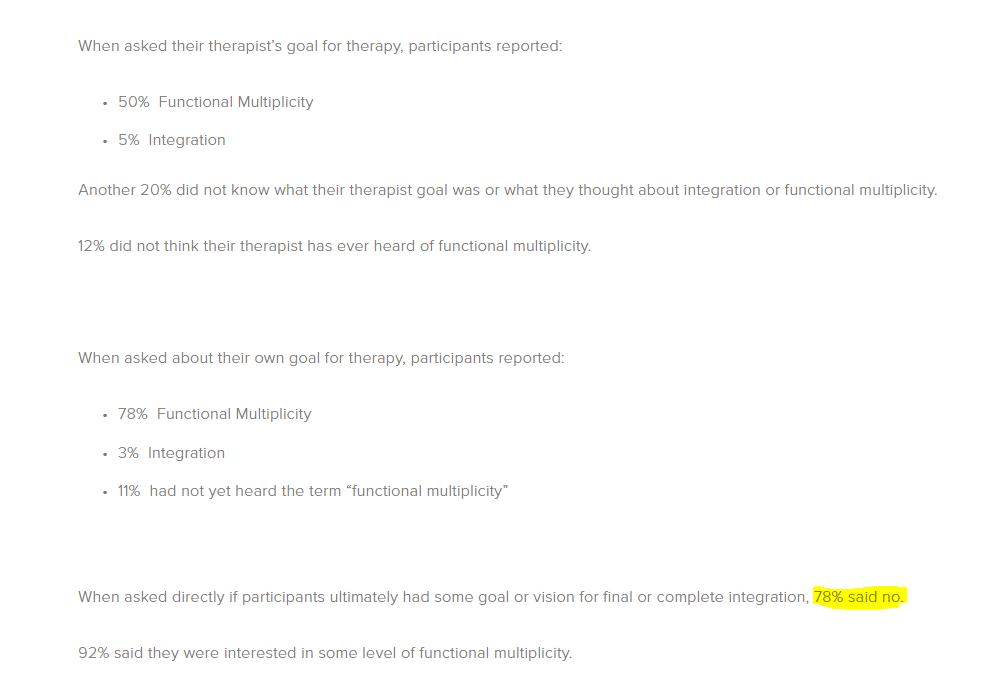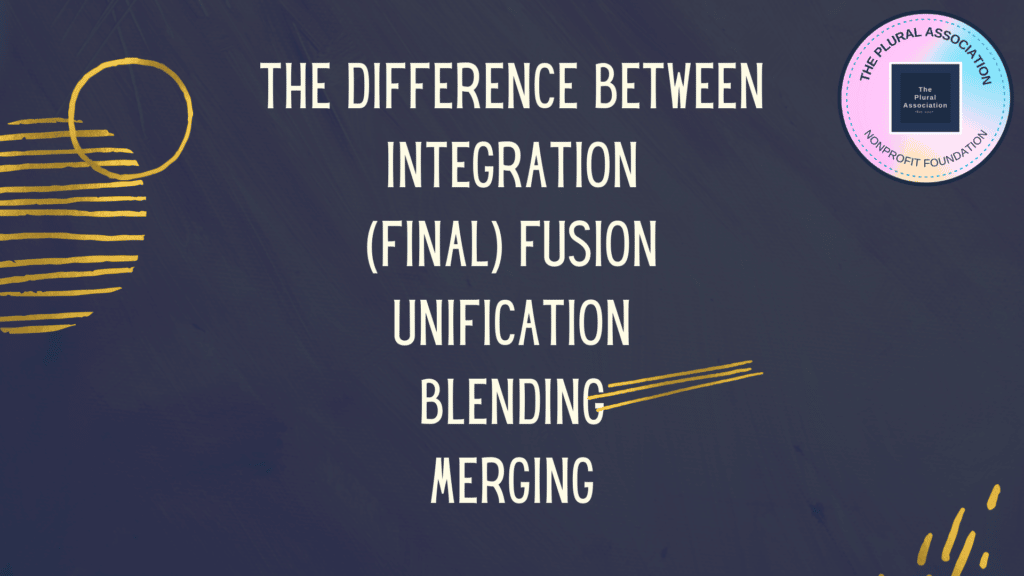|
TPA audio player
|
Author: Stronghold System
Proofreader and editor: The Eki System (Thank you Eki!)
Today we wanted to share with you all some definitions of different terminology that our community often uses interchangeably.
A summary can be found at the end of the article.
The definitions used in this article come from both the ISSTD treatment guidelines for DID and the workbook for therapists ”Treating Trauma Related Dissociation” by the authors Kathy Steele, Suzette Boon and Onno van der Hart (who lost his practicing license for life.)
Let’s start with explaining that different therapists use different words to indicate a similar process and/or end goal (final fusion.) So, it totally makes sense that in our community, we are often talking over each other : we are attempting to have a conversation while we have a different understanding of the meaning of this terminology.
I’m not sure if doctors can’t agree or if they are money and power hungry and just hope their new word becomes the breakthrough new treatment that will make them rich. What I am sure of is that Kluft came up with 3 words to mean the same thing and as shown below, this still causes a lot of confusion.
Let us then look first at the ISSTD guidelines, who go with Kluft’s definitions and ideas:

As you can see the ISSTD guidelines define integration and harmony between alternate identities as the same thing. This is probably why our community started to use the words final fusion, to mean, well, fusion. We will get back to this point in a minute.
They go with Kluft’s 1993 definition of integration, an ongoing process of undoing all aspects of dissociative dividedness. However, just a few paragraphs further down, we can read that Kluft argues that the most stable treatment outcome is final fusion.
So, what is very important to understand, as you can read in the ISSTD guidelines above, is that Kluft says we do integration because it leads to fusion. Because it says that integration is the (ongoing process of) undoing of ALL aspects of dissociative dividedness.
These claims are made more often for example by Jackson, Janet, Meares and Neijenhuis.

It is said (see image below) that fusion is the safest treatment outcome. This was also emphasized at the ToSD conference we attended and when we afterwards asked Onno van der Hart how he knew for sure that final fusion was the best treatment outcome, he said that knowledge came from his clinical observations, just as the image below shows. Clinical observation isn’t the same as dedicated research.
I said I have a different observation, albeit not clinical and he laughed and said, oh yes, i have many clients who call me, when they are angry about it! – He still believes this is the best outcome. With no research to back it up, because we know from the Top DD study (dedicated research) that it has a 12.8% success rate, after MANY years of therapy.

Okay, now let us go a bit deeper into the Theory of Structural Dissociation and we will compare their previous work with their current work.
In their 2006 book ‘The Haunted Self’, Final Fusion is mentioned twice. Once in regards to the great reluctance some patients have around final fusion, and the other about how when thought that final fusion is reached, it turns out often that was not the final fuse/step, more work is to be done.

Here you can really see how they use these words interchangeably. And before that, we saw that integration is supposed to lead to fusion. So it’s no wonder that there is a lot of confusion and a lot of bickering in our community about the right terminology to describe an experience, the desire to have it or objections towards it.
If we look at the newer work by the authors of ToSD, for example in their workbook for therapists called ‘Treating Trauma Related Dissociation”, we can see that they no longer use the word final fusion and instead opted for the word unification.

This example of work by Kluft, compared to the ISSTD guidelines, shows us very clearly that Kluft used (in the 1990’s) integration, (final) fusion and unification at the same time, to mean the same thing.
No wonder there is so much confusion!
After all the research that went into creating this article, it seems to me that it was Kluft who started the confusion, ToSD who built it on it and ISSTD who finalized it in their guidelines, combined with a bunch of lived-experienced stories, told as the one and only truth, by various community members and therapists.

I do think this image explains the different terminology best.
Integration =
”an overarching and ongoing series of actions that goes far beyond the coming together of dissociative parts into one whole […]
Integration of dissociative parts allows for a [one] cohesive sense of self that is consistent and adaptable across time and situations. Patients should no longer experience dissociative symptoms such as amnesia, switching, auditory voices, or passive influence.” – Treating Trauma Related Dissociation.
Fusion = integration of 2 or more parts.
Unification = integration of all parts.
Final Fusion = Unification of all parts.
Blending and merging:
Blending is typically an intentional therapeutic intervention to improve the patient’s functioning or ability to cope through the cooperative temporary merging of two or more parts, for example, for better functioning at work or to deal with a difficult medical procedure that might otherwise be triggering. It can also be used as a trial for the patient to experience what integration between parts might be like (Boon et al., 2011; Fine, 1991; Fine & Comstock, 1989; Kluft, 1993b).
Integration, fusion, unification, final fusion, no matter what you or the clinical community call it, doesn’t mean that ‘parts’ go away.
Instead it means they come together, with the goal to stay together, to be one unified person, with 1 unified personality. ”A cohesive personality and sense of self,” as the ToSD calls it, and without dissociative symptoms such as amnesia, switching, auditory voices, or passive influence.
But for many Plurals, in practice, not switching equals ‘going away.’ Those who have a (positive) fusion experience have expressed clearly and explicitly, that it does not feel like that for them.
No matter how you individually or as a System feel about the topic, the decisions should always be up to you and your System and your therapist should never force it upon you.

So we have established that it should be up to the patient if they want to fuse or not. However, the 3-phase model, the ToSD-based treatment, is focused on fusion integration, even when the patient has no such desire! The therapist is told to continue to ask why the need for parts remains.
(”I wonder what keeps those parts of you separate from you? or Have you ever thought about why those parts still need to be separate from each other? Have you ever thought about why that part of you has never grown up? I’m curious about what it might be like for you if those parts were closer together?”)
The language the therapist is trained to use is suggestive of fusion, and reads (almost) as a sales pitch for their 6-12 year long therapy plan. The summary of this chapter on integration ends with:
”Many patients achieve full integration of their parts—that is, unification—while some do not.”
A year after publishing this book, the top DD study shows a 12.8% success rate for fusion in a 6 year follow-up study. Book/theory/concept dismissed if you ask me, but everyone gets to make their own decisions of course!
There is a clear explanation on why this theory states that we are too disordered if we can’t fuse and no-one explained it better than Anna Preston:
”Another significant feature of this model, as the authors present it, is that dissociation is conceptualized as fundamentally maladaptive and pathological in nature. They urge researchers against emphasizing too strongly the adaptive or defensive nature of dissociation. Dissociation, they argue, serves a defensive function only insofar as it allows the ANP of the individual to continue functioning in daily life. However, this functioning is inevitably compromised by disturbing dissociative symptoms (e.g., feelings of numbness, amnesia, flashbacks). This uncompromisingly pathological view of dissociation is in sharp contrast to many of the other approaches we will consider in this research” – NEW AGE ‘CHANNELING’ AND THEORIES OF DISSOCIATION: APPLYING A ‘STRUCTURAL DISSOCIATION OF THE PERSONALITY’ MODEL TO THE CASE OF JANE ROBERTS – by Anna Preston 2015.
The next image deserves its own trigger warning, as it is, in my humble opinion, extremely offensive and also plain wrong. I wasn’t sure if I should include this, but I don’t want to feel the need to write another article about it next week, so here it is.
I don’t know anyone, and I support 4000 people on a regular basis together with our The Plural Association Nonprofit Team, who isn’t integrating because they are lonely.

In March 2019 Dr. E from System Speak did a community survey which got 863 responses. This showed that 78% of respondents, when directly asked, do not have a goal or vision for final or complete integration. It also showed that 92% were interested in some level of functional multiplicity.
I personally refuse to believe that 78% of them are either extremely lonely or too disordered to reach fusion. It’s black and white thinking and clearly comes from a singular perspective, as it seems that being happy (functional) and Plural isn’t really an option to envision for them.

Functional multiplicity isn’t mentioned in either the treatment guidelines or ToSD. This term came from Kymbra Clayton, who wrote an interesting paper called ”Critiquing the Requirement of Oneness over Multiplicity: An Examination of Dissociative Identity (Disorder) in Five Clinical Texts”
But ToSD assumes that fusion will happen over time, even if the patient doesn’t want it (yet), unless the patient is too disordered* to reach such a fused state!
Which, as you might know, really isn’t mine and many others’ experience. Many of us live healthy, stable, functional lives while we remain Plural and work on cooperation, communication and co-consciousness. But as shown above, ”dissociation is conceptualized as fundamentally maladaptive and pathological in nature.” Hence, in their opinion, one can’t be Plural without that experience being disordered.
(*as shown in images above: ”Some patients with poor prognoses will never integrate and cannot resolve their traumatic memories, that is, move to Phase 2. These patients may be able to achieve some degree of stability, but they remain highly prone to crisis and decompensation. Not all patients achieve a complete integration of all parts, but many are at least able to create enough cooperation among parts to achieve good functioning.”)
So to summarize :
Integration is said to be the continuous action that leads to fusion, whether you want it or not. Somehow it is our own free choice and should not be forced, but simultaneously, in their expertise, it is also what will naturally happen, unless we are too disordered, because ”dissociation is conceptualized as fundamentally maladaptive and pathological in nature.”
(”The therapist did not push the idea, but allowed the patient’s resistance and focused on other integrative actions that provided a natural pathway to unification over time.”)
So, if you don’t want fusion, I wouldn’t work with the ToSD theory, because they say it can lead to integration even if you don’t want it. I respect your opinion and desires around fusion and if they did too, they wouldn’t do this treatment with you, they wouldn’t keep suggesting, repeating and selling that fusion could be so nice. They would have written at least something positive about ‘functional multiplicity’ instead of calling us too disordered or invested in DID as a lifestyle or lonely and pathologize each and every Plural experience.
Or in their own words:
Integration =
”an overarching and ongoing series of actions that goes far beyond the coming together of dissociative parts into one whole […]
Integration of dissociative parts allows for a [one] cohesive sense of self that is consistent and adaptable across time and situations. Patients should no longer experience dissociative symptoms such as amnesia, switching, auditory voices, or passive influence.” – Treating Trauma Related Dissociation.
Fusion = integration of 2 or more parts.
Unification = integration of all parts.
Final Fusion = Unification of all parts.
As always, we encourage you and your System to follow your own truth, to soul search, to find words, labels, visions, theories and communities that aren’t only within your values but also match your lived experience and/or long term goals, so that you might find belonging and don’t have to try to fit in.
Thank you for investing the time to read this article. Please, feel free to leave comments or feedback in the comment section.
The Plural Association is the first and only grassroots, volunteer and peer-led nonprofit empowering Plurals. Our works, including resources like this, are only possible because of support from Plurals and our allies.
If you found this article helpful, please consider making a donation.
Together we empower more Plurals!
Disclaimer: Thank you for reading our peer article; we hope it was empowering, informative and helpful for you and your System. There are as many Plural experiences, as there are Plurals. So not all information on this website might apply to your situation or be helpful to you; please, use caution. We’re not doctors or clinicians and our nonprofit, our work, and this website in no way provide medical advice, nor does it replace therapy or medication in other ways.
About the authors
The Stronghold System are the proud volunteer founders & CEO of The Plural Association Nonprofit. They are from the Netherlands and reside in a 30-something-year-old body, are nonbinary, parents of an amazing child & 3 cats. They got diagnosed with Dissociative Identity Disorder over 10 years ago & also self ID as Plural.
-
Strongholdhttps://powertotheplurals.com/author/stronghold/
-
Strongholdhttps://powertotheplurals.com/author/stronghold/
-
Strongholdhttps://powertotheplurals.com/author/stronghold/
-
Strongholdhttps://powertotheplurals.com/author/stronghold/


Pingback: Integration: 12.8% times two - Our strong response to the six-year follow-up TOP DD study. - powertotheplurals.com
Pingback: Integration, the double edge sword:‘’If it’s not broken, don’t fix it!’’ - powertotheplurals.com
Pingback: Why the theory of Structural dissociation is ableist - A strong opinionated article. - powertotheplurals.com
Pingback: MPD to DID 25 years later - Integration & final fusion. - powertotheplurals.com
I’m glad I learned the word functional multiplicity, it even pops up as I type into my phone;which is reassuring. It’s what I want, because I do love my others and they are unique people I have compassion for. Which their own wants and beliefs. I hope my therapist is open minded about this as she seems to have no knowledge or training in such matters. I prefer to call it multiple personality because for me that’s what it’s like. Through your help I have learned to work together and listen to each other. I’m still at the begging but I can’t wait to see how things unfold.
wonderful article thank you! jsyk the tpa audio player is screwed up it repeats chunks of text 2-3 times over.
Pingback: What is integration in dissociative identity disorder?
Those questions that are intended to “encourage the patient to pursue unification”, do so by eroding patient agency and with that their well being. This “Questioning” is discussed by Theo L. Dorpat who explains that it is a form of covert control and should be seen as patient abuse. Regardless of whether one desires unification, the mere fact that ToSD encourages patient abuse is enough reason to avoid it.